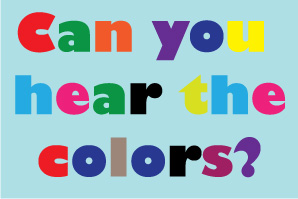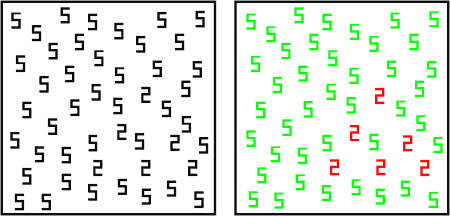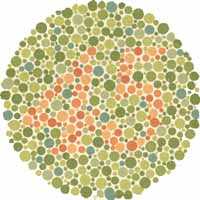 Some time ago, my older brother Mans was working as editor of a Dutch magazine for university graduates. He pointed out one of the articles he had been working on, which dealt with the somewhat obscure subject of “cross-sensory experiences” known as Synesthesia.
Some time ago, my older brother Mans was working as editor of a Dutch magazine for university graduates. He pointed out one of the articles he had been working on, which dealt with the somewhat obscure subject of “cross-sensory experiences” known as Synesthesia.
At first glance, synesthesia appears to fall into the same category as telepathy, clairvoyancy and what not. Let’s face it: people who can hear colours or taste numbers are the kind of thing we hear about on late night radio chat shows, purely for entertainment – but not to be taken seriously.
As it turns out, there’s far more to synesthesia that meets the eye – or the ear, for that matter. It was a popular topic of research in the late 1800s, but then again, so was the idea of creating life through electricity. Largely abandoned in the 20th century, synesthesia has only recently returned to the radar of scientific research, which is how the article in my brother’s magazine came about.
Everyone is familiar with metaphors such as “loud colours”, “colourful language” or “bitter cold”. Appropriate as these descriptions may appear, for some people this mixup – or maybe enhancement – of the senses is an actual reality. The most widely experienced and researched form of this phenomenon appears to be grapheme-colour synesthesia, where the person perceives letters or numbers as having different colours. This is also a form which can easily be tested independently – unlike, say, lexical-gustatory synesthesia, where one associates different tastes with different words.

The tests for grapheme-colour synesthesia are very similar to those for colour blindness. The person is shown an image made up randomly arranged different letters or numbers. Certain identical numbers however, have been arranged in a recognisable pattern – which can only be easily perceived by someone who is a synesthete. In the simplified example shown here, a synthesist may see the black and white pattern shown on the left as something like that shown on the right.
 If you think that is strange or maybe even impossible, then consider the substantial proportion of the male population who, like myself, are partially or wholly colour blind. When we are presented with the familiar circular images that have a number or letter displayed by means of a differently coloured pattern, chances are that we simply see a bunch of dots, and nothing else – which is exactly what I see in the circle displayed here. Nothing. Somebody who does see the pattern that makes up the number 45 (apparently), is seeing something that does not exist, as far as I’m concerned. Only, in the case of us – the colour blind – we constitute a minority and the people who can see the hidden pattern are not considered strange. To suggest that colour blindness has anything to do with intelligence (as the ad for wixawin.com below does) is of course a completely different matter – but I digress.
If you think that is strange or maybe even impossible, then consider the substantial proportion of the male population who, like myself, are partially or wholly colour blind. When we are presented with the familiar circular images that have a number or letter displayed by means of a differently coloured pattern, chances are that we simply see a bunch of dots, and nothing else – which is exactly what I see in the circle displayed here. Nothing. Somebody who does see the pattern that makes up the number 45 (apparently), is seeing something that does not exist, as far as I’m concerned. Only, in the case of us – the colour blind – we constitute a minority and the people who can see the hidden pattern are not considered strange. To suggest that colour blindness has anything to do with intelligence (as the ad for wixawin.com below does) is of course a completely different matter – but I digress.

Like the colour blind, people who have synesthesia do no consider themselves to “suffer” from a condition. It does not interfere with the person’s ability to function and it appears that synesthetes are born “that way” and only find out over time that their experience of the world around them differs from that of other people.
Once you start considering synesthesia as a reality, it seems to be a part of many people’s lives to a much greater extent that one would have thought. Just think about all those people who cannot bear the sound of fingernails scraping over a blackboard, for example. Why on earth would a simple sound make somebody feel physically uncomfortable? Goose bumps at the sound of beautiful music, the power of smell to evoke memories… Maybe these more familiar “cross-sensory” experiences are pointers to the more dramatic synesthesia experienced by only some of us.
There’s quite an extensive article on WikiPedia on this subject – for those who want to know more about what the days of the week taste like or what the colour red sounds like.
We see lots of stuff based around this in brand research. The questions posed often range around “if Brand X were a colour, what colour would it be?”. Mind you I have also seen “If Brand X were a film star, a rock band, a car, etc.”. As I type, the direct association gets less and less. A second excellent blog, Pier.
Excellent piece Pier! I knew that ‘intelligence’ test was a real irritant for you.
I never realised that you were colour blind. A finished artist i used to work with was in his 30’s before realising that he was colour blind and saw colours differently from everyone else in the studio. It revealed itself one day when he and I had a slightly heated argument over a Pantone colour he referred to as gray when it was actually a green. When everyone else confirmed to him that he was wrong he was mortified. His next thought was whether his colour blindness would jeopardise his career…. Working in a job where colours are a vital part of your work etc etc. It didn’t.
I know someone who says they can see colour auras around people but have the ability to switch the synesthesia on and off. For me though, the most interesting synesthesia is the one where the ‘sufferer’ sees colours when listening to music… Just like having a built-in iTunes visualiser. Think I would like to have that one.
I look forward to your next blog.
Gerry
Being colour blind is not as black and white (pardon the pun) as some people will have it. When I applied for the finished art course at the Amsterdamse Grafische School (“Amsterdam School for the Printing Trade”), prospective students had to do a simple colour test. I passed, even if only just. The problem only occurs with certain hues of blue and green as far as I can tell. And no, I have no problem with traffic lights. The arrival of computers in our profession has made life somewhat easier, since the applications we now use will simply tell you the breakdown of various colours :-)
With regard the ability of some people to see coloured “auras” around other people – I’m not sure if that fits the definition of synesthesia. The aura phenomenon appears to point to some sort of sixth sense, whereas synesthesia seems to deal with a mixup of the five traditionally recognised senses. But maybe I’m wrong!
I wrote a psychology paper back in cleolge (~1976) about synesthesia, because I could really hear colors and see some sounds, (tho rarely taste words or smell music). There had been an article about synesthesia in Psychology Today, a magazine my mother subscribed to. Finally I had a term that could describe my condition . I wish I still had my paper; someone stole it from the professor’s office after he mentioned it in class. (That was back in the days of typewriters and I hadn’t made a carbon copy.)It’s interesting that these sensations aren’t as strong in me as they once were.
The reading of auras is probably more a matter of religion, whereas synesthesia is a neurological phenomenon. Somehow the wiring in the brain for the processing of sensory information gets mixed up. The condition is hereditary, but it is not really a malfunction. The synesthetes I know are glad to have the condition. In learning things by heart, for instance, it helps to see that certain words are blue, or yellow. Those of us who lack the condition (or gift, or talent, or whatever it should be called) are probably to be pitied (even more so than the colour blind).
Incidentallly, jonge vriend, I am very glad to find you blogging. That makes it easier for me to “keep you in the holes”, if I am allowed a Dutch expression. I hope you’ll continue to find the time to write at the level of excellence you’ve demonstrated so far.
I also have synesthesia sonuds, touch, feelings make me see colour & shapes .I’ve been pretty good at filtering it while having conversations though- although its the worst if Im sick or in a lot of pain, where colours and shapes will just go crazy like a bad drug trip. It helps me memorise the spelling or order of words, because if letters are out of place the word will be the wrong colour, and information can also be coded by my brain into colours for study. I think synesthesia is pretty common, but alot of people dont realise they have it because they think everyone thinks like that since I was little I used to tell my mum what colours and shapes things were, but she thought I was just being a silly kid until she discovered it.-Morgan
A grapheme-color story: I’ve known about sehistnysea since I was in high school, in 1972 or so. A few years ago I learned hiragana (not the language, just the syllabary). The characters just looked black and white at first. Then as I got familiar with them and their sounds, color faded in.Skeets, music looks like sometimes thin red lines in the upper left, sometimes parallel lines straight ahead, which are brown, sometimes strings of beads or cascades of shiny triangles. This is classical music I’m describing but other kinds have similar visual effects.